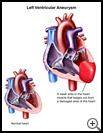
Left Ventricular Aneurysm
________________________________________________________________________
KEY POINTS
- A left ventricular aneurysm is a weak area in the heart muscle that bulges out from a damaged area of the heart. The left ventricle is the left lower chamber of the heart that pumps oxygen-rich blood from your lungs to the rest of your body.
- Many left ventricular aneurysms are small and don’t need treatment. Treatment for large aneurysms may include medicines or surgery.
- Take care of your health. Ask your provider what symptoms or problems you should watch for and what to do if you have them.
________________________________________________________________________
What is a left ventricular aneurysm?
A left ventricular aneurysm is a weak area in the heart muscle that bulges out from a damaged area of the heart. The left ventricle is the left lower chamber of the heart that pumps oxygen-rich blood from your lungs to the rest of your body.
What is the cause?
A heart attack can cause some of the heart muscle to die. When part of the heart muscle dies, a scar can form on the muscle. Over time, the scar may get thin and start to stretch, causing an aneurysm. The aneurysm bulges outward much like a weak spot on a car tire. Unlike the tire, it rarely bursts, but it may greatly reduce how well your heart can pump.
Aneurysms usually form and get bigger during the first few months after a heart attack. Why they form in some people and not in others is not known.
What are the symptoms?
A left ventricular aneurysm does not cause any symptoms.
A large ventricular aneurysm may make it harder for your heart to pump blood to the rest of the body. This problem is called heart failure. Symptoms of heart failure include shortness of breath or trouble breathing, swelling in the feet and legs, weight gain, coughing, feeling like your heart is racing or fluttering, and lightheadedness or fainting.
Blood clots may form in left ventricular aneurysms. A blood clot can break off and travel through the bloodstream until it blocks a blood vessel. This may cause strokes or other organ damage.
Often people with heart aneurysms also have a fast or irregular heartbeat.
How is it diagnosed?
Your healthcare provider will ask about your symptoms and medical history and examine you. If your provider thinks that you have a left ventricular aneurysm, you may have tests such as:
- An echocardiogram, which uses sound waves (ultrasound) to measure the size of the aneurysm and to see how well your heart is pumping
- Heart catheterization, which uses a small tube called a catheter inserted into a blood vessel, dye, and X-rays to look at your coronary arteries and heart and see how well your heart is pumping
How is it treated?
Aneurysms range from very small (thumbnail size) to very large (doubling the size of the heart). Many left ventricular aneurysms are small and don’t need treatment. Treatments for large aneurysms include:
- Medicines to treat heart failure. You may also need to eat a low-salt diet.
- Anticoagulant medicine (blood thinners) to prevent blood clots.
- Medicines to treat heart rhythm problems. You may need a device called an implantable cardioverter defibrillator (ICD). An ICD is a small battery-powered device that is placed under the skin in your chest or belly. The device helps your heart beat in a normal rhythm.
If you have severe symptoms that are not helped by these treatments, you may need surgery to remove the aneurysm.
How can I take care of myself?
Follow the full course of treatment prescribed by your healthcare provider.
Take care of your health. Try to get at least 7 to 9 hours of sleep each night. Eat a healthy diet and try to keep a healthy weight. If you smoke, try to quit. If you want to drink alcohol, ask your healthcare provider how much is safe for you to drink. Learn ways to manage stress. Exercise according to your healthcare provider's instructions.
Ask your provider:
- How and when you will get your test results
- If there are activities you should avoid and when you can return to your normal activities
- How to take care of yourself at home
- What symptoms or problems you should watch for and what to do if you have them
Make sure you know when you should come back for a checkup. Keep all appointments for provider visits or tests.
How can a ventricular aneurysm be prevented?
Some aneurysms may be prevented if a heart attack is treated very soon after it starts.

